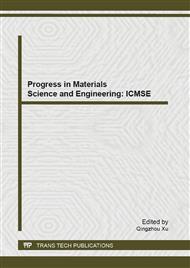[1]
B.E. Logan, B. Hamelers, R. Rozendal, U. Schroder, J. Keller, S. Freguia, P. Aelterman, W. Verstraete, K. Rabaey, Microbial Fuel Cells: Methodology and Technology, Environ. Sci. Technol. 40 (2006) 5181-5192.
DOI: 10.1021/es0605016
Google Scholar
[2]
M. Zhou, M. Chi, J. Luo, H. He, T. Jin, An overview of electrode materials in microbial fuel cells, J. Power Sources 196 (2011) 4427-4435.
DOI: 10.1016/j.jpowsour.2011.01.012
Google Scholar
[3]
J. Wei, P. Liang, X. Huang, Recent progress in electrodes for microbial fuel cells, Bioresource Technol. 102 (2011) 9335-9344.
DOI: 10.1016/j.biortech.2011.07.019
Google Scholar
[4]
S. Cheng, B.E. Logan, Ammonia treatment of carbon cloth anodes to enhance power generation of microbial fuel cells, Electrochem. Commun. 9 (2007) 492-496.
DOI: 10.1016/j.elecom.2006.10.023
Google Scholar
[5]
K. Scott, G.A. Rimbu, K.P. Katuri, K.K. Prasad, I.M. Head, Application of Modified Carbon Anodes in Microbial Fuel Cells, Process Saf. Environ. 85 (2007) 481-488.
DOI: 10.1205/psep07018
Google Scholar
[6]
Y. Feng, Q. Yang, X. Wang, B.E. Logan, Treatment of carbon fiber brush anodes for improving power generation in air–cathode microbial fuel cells, J J. Power Sources 195 (2010) 1841-1844.
DOI: 10.1016/j.jpowsour.2009.10.030
Google Scholar
[7]
Y. Zou, C. Xiang, L. Yang, L. -X. Sun, F. Xu, Z. Cao, A mediatorless microbial fuel cell using polypyrrole coated carbon nanotubes composite as anode material, Int. J. Hydrogen Energ. 33 (2008) 4856-4862.
DOI: 10.1016/j.ijhydene.2008.06.061
Google Scholar
[8]
T. Sharma, A.L. Mohana Reddy, T.S. Chandra, S. Ramaprabhu, Development of carbon nanotubes and nanofluids based microbial fuel cell, Int. J. Hydrogen Energ. 33 (2008) 6749-6754.
DOI: 10.1016/j.ijhydene.2008.05.112
Google Scholar
[9]
D.A. Lowy, L.M. Tender, J.G. Zeikus, D.H. Park, D.R. Lovley, Harvesting energy from the marine sediment-water interface II: Kinetic activity of anode materials, Biosens. Bioelectron. 21 (2006) 2058-(2063).
DOI: 10.1016/j.bios.2006.01.033
Google Scholar
[10]
W. Liu, J. Zhang, C. Cheng, G. Tian, C. Zhang, Ultrasonic-assisted sodium hypochlorite oxidation of activated carbons for enhanced removal of Co(II) from aqueous solutions, Chem. Eng. J. 175 (2011) 24-32.
DOI: 10.1016/j.cej.2011.09.004
Google Scholar
[11]
F. Yu, J. Ji, Z. Xu, H. Liu, Effect of ultrasonic power on the structure of activated carbon and the activities of Ru/AC catalyst, Ultrasonics 44 (2006) 389-392.
DOI: 10.1016/j.ultras.2006.05.005
Google Scholar
[12]
X. Wang, S. Cheng, Y. Feng, M.D. Merrill, T. Saito, B.E. Logan, Use of Carbon Mesh Anodes and the Effect of Different Pretreatment Methods on Power Production in Microbial Fuel Cells, Environ. Sci. Technol. 43 (2009) 6870-6874.
DOI: 10.1021/es900997w
Google Scholar
[13]
H. Cai, J. Wang, Y. Bu, Q. Zhong, Treatment of carbon cloth anodes for improving power generation in a dual-chamber microbial fuel cell, J. Chem. Technol. Biot. 88 (2012) 623-628.
DOI: 10.1002/jctb.3875
Google Scholar
[14]
S. Cheng, H. Liu, B.E. Logan, Increased Power Generation in a Continuous Flow MFC with Advective Flow through the Porous Anode and Reduced Electrode Spacing, Environ. Sci. Technol. 40 (2006) 2426-2432.
DOI: 10.1021/es051652w
Google Scholar
[15]
S. Cheng, J. Wu, Air-cathode preparation with activated carbon as catalyst, PTFE as binder and nickel foam as current collector for microbial fuel cells, Bioelectrochemistry 92 (2013) 22-26.
DOI: 10.1016/j.bioelechem.2013.03.001
Google Scholar
[16]
D.R. Lovley, E.J.P. Phillips, Novel Mode of Microbial Energy Metabolism: Organic Carbon Oxidation Coupled to Dissimilatory Reduction of Iron or Manganese, Appl. Environ. Microb. 54 (1988) 1472-1480.
DOI: 10.1128/aem.54.6.1472-1480.1988
Google Scholar
[17]
U. Schroder, Anodic electron transfer mechanisms in microbial fuel cells and their energy efficiency, Phys. Chem. Chem. Phys. 9 (2007) 2619-2629.
DOI: 10.1039/b703627m
Google Scholar
[18]
J.P. Busalmen, A. Esteve-Nuñez, J.M. Feliu, Whole Cell Electrochemistry of Electricity-Producing Microorganisms Evidence an Adaptation for Optimal Exocellular Electron Transport, Environ. Sci. Technol. 42 (2008) 2445-2450.
DOI: 10.1021/es702569y
Google Scholar
[19]
C. Léger, S.J. Elliott, K.R. Hoke, L.J.C. Jeuken, A.K. Jones, F.A. Armstrong, Enzyme Electrokinetics: Using Protein Film Voltammetry To Investigate Redox Enzymes and Their Mechanisms, Biochemistry 42 (2003) 8653-8662.
DOI: 10.1021/bi034789c
Google Scholar
[20]
K. Yokoyama, Y. Kayanuma, Cyclic Voltammetric Simulation for Electrochemically Mediated Enzyme Reaction and Determination of Enzyme Kinetic Constants, Anal. Chem. 70 (1998) 3368-3376.
DOI: 10.1021/ac9711807
Google Scholar


